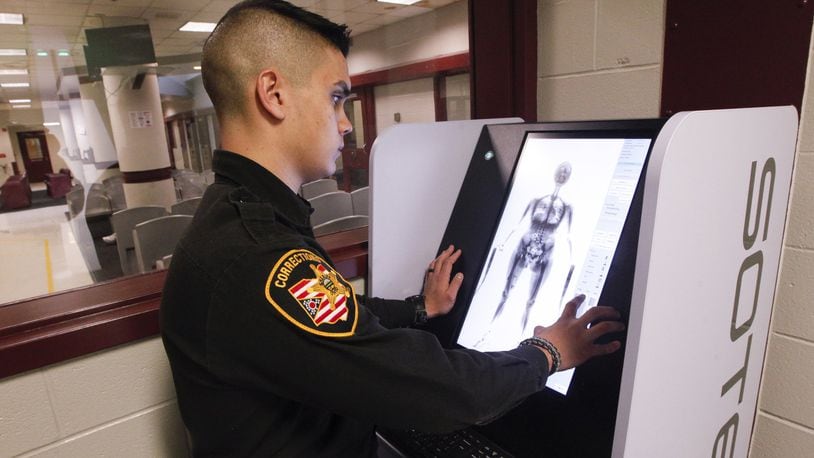Some in custody will be scanned multiple times as they return from court dates and work details.
RELATED: Counties struggle to keep drugs out of their jails
Montgomery County Sheriff’s officials will flip the switch soon on the new system designed to keep contraband out of the jail — including dangerous opioids that continue to slip in and cause overdoses behind bars.
Streck said one factor makes the machine almost indispensable: its ability to detect objects in body cavities without conducting an invasive search.
“The big thing is people smuggling opiates or other types of drugs inside them and it gets into our jail,” Streck said. “That was the big concern that brought these body scanners really to the forefront for county jails, to ensure inmates didn’t get up into the housing units, pull out some drugs and overdose.”
MORE: County spending on jail lawsuits tops $1M
While the frequency of drug overdoses eased in recent months, during 2016 and the first half of 2017, the jail staff dealt with several inmate overdoses a month, Streck said.
One inmate, Dustin Ryback, died in November 2016 of a fentanyl overdose, the Montgomery County coroner determined. Another inmate was accused of supplying the deadly opioid from inside the walls.
Purchase of the $118,750 machine from OD Security North America was approved last July by Montgomery County Commissioners. About $40,000 was spent to modify the intake area of the jail to accommodate the scanner which was installed three weeks ago. Because the scanner is a radiological device, it required a state health department inspection, completed last week.
RELATED: Full-body scanner purchased for Montgomery County Jail
The machine can make a scan in about 10 seconds. But it takes trained corrections officers like Tyler Viernes to make sense of the resulting images.
“You can see that the scanner picked up a foreign object located in her body,” Viernes said pointing to a test scan on the new, large touch-screen. “It easily picks up anything metal, which would be darkened … Different filters will definitely help you get a better view of what they have.”
Up to two corrections officers per shift — who went through a weeklong training — are being reassigned to operate the scanner, Streck said.
RELATED: Greene Co. Jail buys scanner to combat drug smuggling
A similar system has already proved itself at the Greene County Jail since it went into operation in late September, said Maj. Kirk Keller, the jail administrator.
“The amount of drugs that people were attempting to bring in has been effectively reduced,” he said “It has identified drugs — drugs either in or on their body. So it’s been a great asset for us trying to keep the inmates safe.”
MORE: Miami County step closer to using body scanner at jail
Pat-downs were the most thorough search a county officer could conduct before the scanners were approved, Keller said. Ohio law prohibits pre-sentencing facilities like the county jails from performing strip searches without probable cause.
“The scanner permits a non-intrusive measure to allow us to see if there is something in or on a person that a pat-down might miss,” he said.
Cost of the systems also dropped by a half in the last couple years, making them more affordable for counties, said Streck, who was quoted $270,000 when first looking for a system for Montgomery County.
The lower costs helped nearby counties bring body scanning systems last year to jails, including those in Butler and Miami counties. Warren County is holding off on a scanner until construction of a new $50 million jail planned for 2020.
RELATED: New Butler County Jail body scanner deters weapon, drug smuggling
MORE: Warren County moves forward with new jail construction project
About the Author
